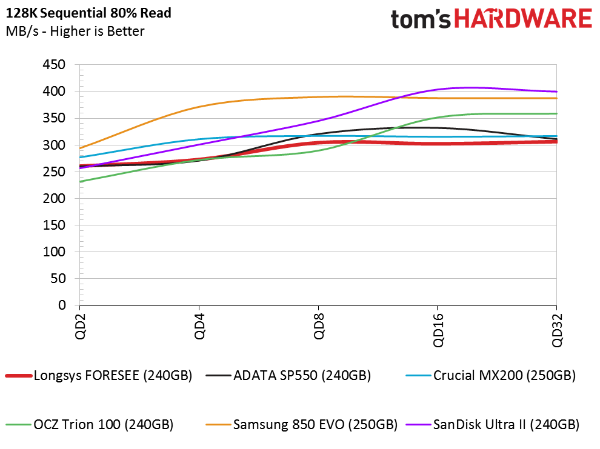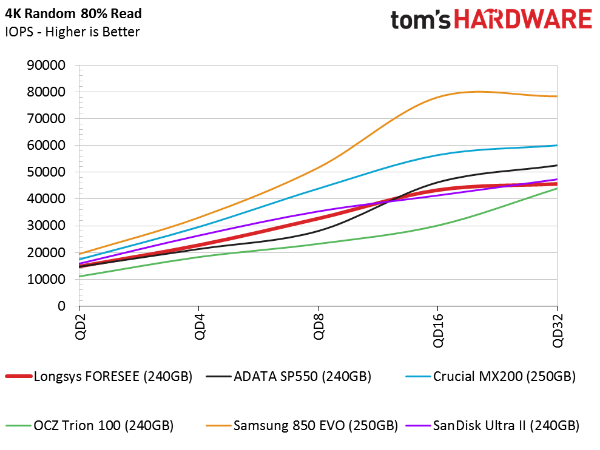Longsys Foresee S500 SSD Review
Longsys, the largest SSD manufacturer in China, sent over a new client SSD armed with Toshiba's triple-level-cell NAND flash and a controller from Silicon Motion that you'll be seeing a lot of over the next year.
Why you can trust Tom's Hardware
Mixed Workload and Steady State
Our mixed workload testing is described in detail here, and our steady state tests are described here.
80 Percent Sequential Mixed Workload
Mixing reads and writes certainly opens a gap in sequential performance between our charted SSDs. We see even more separation than what we observed in the 100 percent read test.
Longsys' S500 doesn't fare as well as it did in the previous sequential metric. Again, we put the most value on queue depths of two and four.
80 Percent Random Mixed Workload
Now we're mixing random 4KB block sizes, with an emphasis on the low to middle range. Even at queue depths of two, four and eight, we see a fair amount of separation, with Samsung's 850 EVO leading the way. The Trion 100 lags behind the other models, including Longsys' Foresee S500, which shows up in the middle.
Sequential Steady State
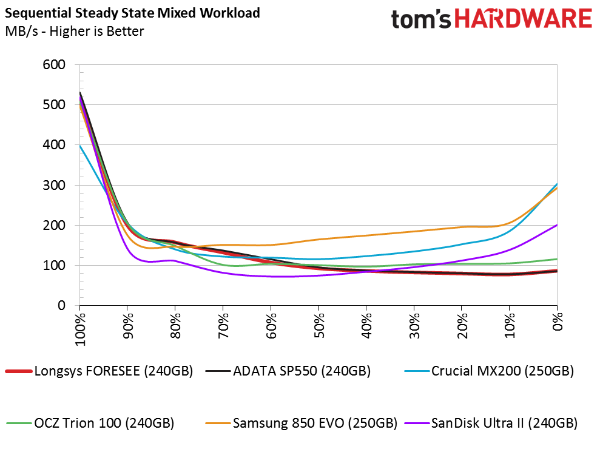
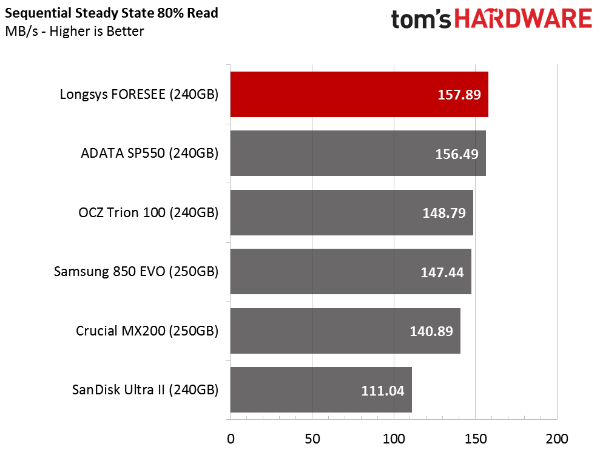
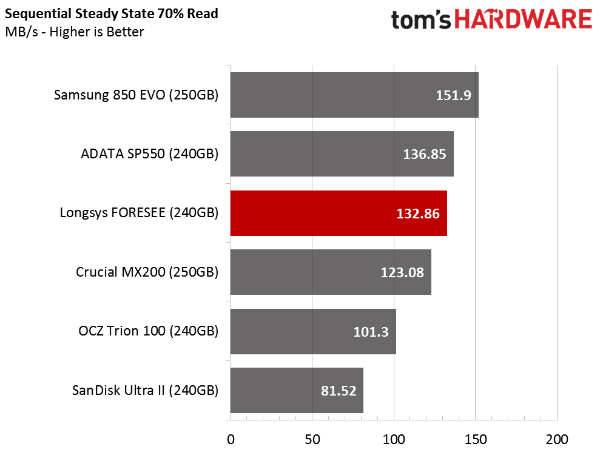
For most of you, our sequential steady state test won't mean much. It takes a workstation-class customer manipulating massive audio and video files to derive true utility from this benchmark.
Subjected to 80 percent reads, the S500 performs better than any other drive in the chart. But by the 70 percent read mark, it drops to the middle. The S500 is not an SSD you want if you're working with large files on a workstation. Performance can drop to sub-mechanical storage levels under those workloads.
Random Write Steady State
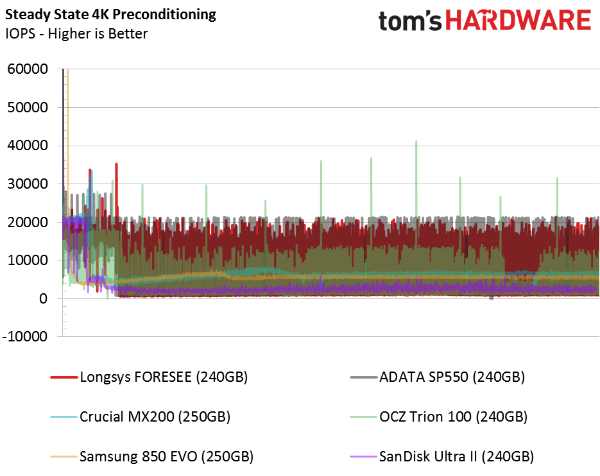
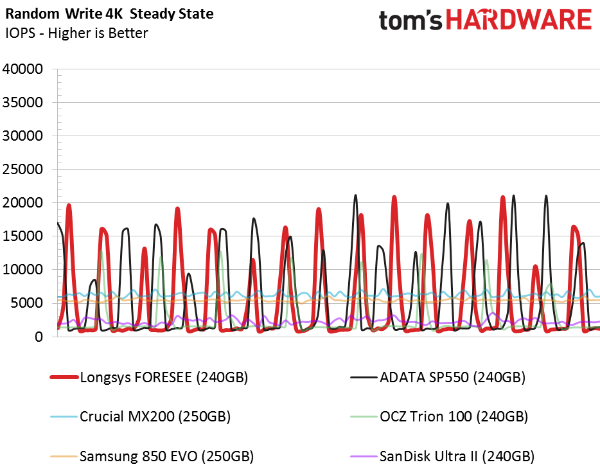
We use the random steady state tests to identify SSDs that might work well in RAID arrays. We're looking for high and consistent random write performance. The less variation observed at the high and low points, the better.
Get Tom's Hardware's best news and in-depth reviews, straight to your inbox.
Both the Longsys S500 and Adata SP550 achieve admirable peaks. At the same time, they dip to disappointing lows as well. This deviation makes the SMI SM2256 controller a poor choice for RAID arrays.
Current page: Mixed Workload and Steady State
Prev Page Four-Corner Testing Next Page Real-World Software Performance Testing
Chris Ramseyer was a senior contributing editor for Tom's Hardware. He tested and reviewed consumer storage.
-
kalmquist The Silicon Motion's SM2256 based drives have the dubious distinction of being slower than what came before. I'm hoping that once companies other than Samsung get 3D NAND into mass production, we will see SSD's priced like the Longsys' Foresee S500, but with better performance.Reply
-
Jeffs0418 Replywonder how many backdoors they included...
I was thinking the same thing. Just the possibility is a deal breaker for me.
I just hope the (Korean) Samsung 850 EVO I purchased this year (Made in China)
has no unwelcome firmware inside. -
photonboy The PRICE is right where it should be. It doesn't perform as well as slightly more expensive drives.Reply -
photonboy TbsToy,Reply
How do you know there is no support? Do you read Chinese?
These exist in China, so I'm not sure why you would expect to easily find the support site. -
TbsToy Reply16962018 said:TbsToy,
How do you know there is no support? Do you read Chinese?
These exist in China, so I'm not sure why you would expect to easily find the support site.
Well, being in Los Angeles California USA and an English speaking American, I haven't ever felt the need to learn to read and speak Chinese just to be able to communicate with an unfindable Chinese support site for some substandard SSD that might not exist a month from now with a site ya can't even find. I can walk to Intel and with no time, and with no language or communication or warranty or shipment issues back and forth.. So I agree with you cuz ya might not have any usable support like the many SSD vendors have here. That shouldn't deter any potential buyers though, right, cuz it is cheap and ya wanna sell em, Right?
Walt Prill -
hannibal I just have to wonder, if most of the readers actually did read the article. This is not about Longsys, this is about controller, that will be the dominant controller in the next two years. Expect to see these in low price Samsung, Munchkin, Kingston etc ssd drives in near future.Reply
